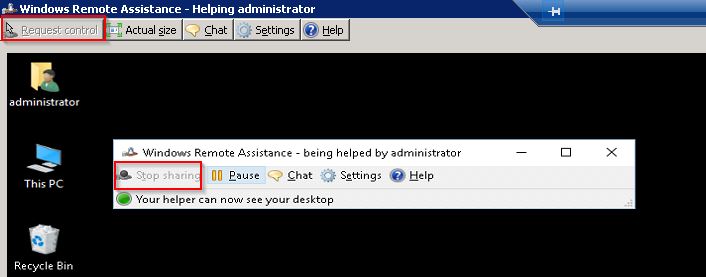 -->
-->Quick Assist is a new app in Windows 10 that enables you to receive or provide assistance over a remote connection. We encourage you to try Quick Assist for a more streamlined, easy-to-use experience. There was a problem starting Remote Assistance - Remote Assistance is unavailable for the current user account. If you are using a Windows Guest account try logging in with another account. If you are not using a Guest account, try restarting your machine. Apr 06, 2021 MS-RA: Remote Assistance Protocol. 4/6/2021; 4 minutes to read; In this article. Specifies the Remote Assistance Protocol, which is used after a remote assistance connection is established between two computers. This page and associated content may be updated frequently. We recommend you subscribe to the RSS feed to receive update notifications. 5 ways to open Remote Assistance in Windows 10: Way 1: Turn it on by searching. Type msra in the search box on taskbar and click msra in the list. Way 2: Open it via Run. Use Windows+R to show the Run dialog, input msra and tap OK. Mar 03, 2020 Third party normally has a lot of functionality which is needed in enterprise environments like extensive logging/auditing etc. All third party products normally support also the elevation scenario, but there is a way to accomplish remote support even with the Windows 10 built-in Quick Assist solution.
The Microsoft-Windows-RemoteAssistance-Exe component enables a user with a computer problem to receive assistance from another person who is located elsewhere. The helper can be a friend or a support professional. In the corporate environment, the helper is usually an employee receiving help from the corporate IT helpdesk. In the home environment, the user is often receiving help from a friend or a family member who is a power user and is remotely located.
To enable remote assistance, you must configure the Windows Firewall. Use the FirstLogonCommands setting to create a command that configures Windows Firewall. Use Netsh to enable Remote Assistance. For example,

netsh advfirewall firewall set rule group='Remote Assistance' new enable=yes
In This Section
| Setting | Description |
|---|---|
| CreateEncryptedOnlyTickets | Specifies whether only encrypted tickets are created. |
| fAllowToGetHelp | Specifies that a user can request help from a friend or a support professional. |
| fAllowFullControl | Specifies that a friend or a support professional can take control of the computer of the person requesting assistance. |
| MaxTicketExpiry | Specifies the maximum amount of time that a ticket can live. |
| MaxTicketExpiryUnits | Specifies the units for the maximum amount of time that a ticket can live. |
Applies To

To determine whether a component applies to the image you’re building, load your image into Windows SIM and search for the component or setting name. For information on how to view components and settings, see Configure Components and Settings in an Answer File.
Related topics
Quick Assist is a new app in Windows 10 that enables you to receive or provide assistance over a remote connection. We encourage you to try Quick Assist for a more streamlined, easy-to-use experience.
Open Quick Assist
Select Start > Quick Assist.

Give assistance
Select Start > Quick Assist (or select the Start button, type Quick Assist in the search box, then select it in the results). Select Assist another person, then send the 6-digit code to the person you're helping. When they've entered it, select either Take full control or View screen. Select Continue and wait for the person you're helping to allow the connection.
Get assistance
Microsoft Windows Remote Assistance Windows 7
Select Start > Quick Assist (or select the Start button, type Quick Assist in the search box, then select it in the results). In the Code from assistant box, enter the 6-digit code you were given, and select Share sceen. Wait for your helper, then select Allow Gomba jahbari discografia completa. in the window that displays.
Send Invitation For Remote Assistance
You can also use Windows Remote Assistance and Easy Connect to give and receive remote assistance.
